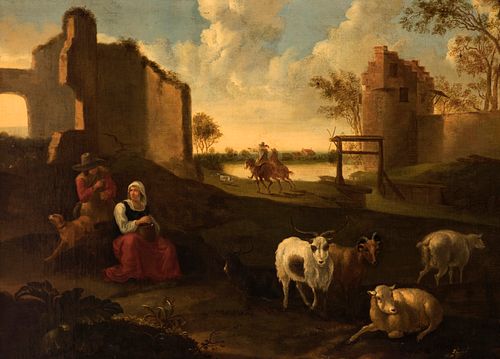Dutch school; 18th century. "Pastoral scene". Oil on canvas. Relined.
Lot 31
About Seller
Setdart Auction House
Carrer Aragó 346
Barcelona
Spain
Setdart Subastas was born in 2004 and is currently the first online art auction in Spain with solidity, prestige and reliability guaranteed by our more than 60,000 users. Setdart has a young, dynamic and enterprising team ready to successfully manage the purchase and sale of art works through custom...Read more
Estimate:
EUR€2,000 - EUR€2,500
$2,150.54 - $2,688.17
Absentee vs Live bid
Two ways to bid:
- Leave a max absentee bid and the platform will bid on your behalf up to your maximum bid during the live auction.
- Bid live during the auction and your bids will be submitted real-time to the auctioneer.
Bid Increments
| Price | Bid Increment |
|---|---|
| EUR€0 | EUR€10 |
| EUR€200 | EUR€25 |
| EUR€500 | EUR€50 |
| EUR€1,000 | EUR€100 |
| EUR€3,000 | EUR€200 |
| EUR€5,000 | EUR€500 |
| EUR€10,000 | EUR€1,000 |
| EUR€20,000 | EUR€2,000 |
| EUR€50,000 | EUR€5,000 |
About Auction
By Setdart Auction House
Nov 3, 2021
Set Reminder
2021-11-03 08:00:00
2021-11-03 08:00:00
America/New_York
Bidsquare
Bidsquare : OLD MASTERS
https://www.bidsquare.com/auctions/setdart-auction-house/old-masters-7786
Setdart Auction House sofia@setdart.com
Setdart Auction House sofia@setdart.com
- Lot Description
Dutch school; 18th century. "Pastoral scene". Oil on canvas. Relined. Presents Dutch style frame of the twentieth century. Measurements: 92 x 127 cm; 116 x 151 cm (frame). Oil on canvas of horizontal format, in which an image of country or pastoral character is developed. In the foreground, the author places two characters accompanied by several goats. Due to the important presence of the landscape and the small dimensions of the characters, the author's special interest in capturing the landscape is evident. It is worth mentioning that this was a time in which the feeling that human and nature should be complementary, one reflected in the other, began to beat. That is to say, the landscape should arouse emotion and transmit ideas. Thus, landscape painters like the author of this painting tried to express their feelings through the landscape, instead of imitating it. This idea was established through two main aspects: the dramatic, of turbulent and fantastic views, and the naturalistic, which emphasized images of a peaceful and serene nature, as in this case. It is this second conception that we see embodied in this work; the painter tries to communicate a religious reverence for the landscape, nature in its fullness, free from the industrial elements of modern life. In fact, the painter's use of light here conveys a dreamy atmosphere that invites the viewer to meditate and contemplate himself in the landscape. However, the landscape is made up of manifestations of very different types and not comparable to each other; it does not affect all the national schools equally, remaining more faithful to the tradition in schools such as the Italian, French or Dutch. Thus, in this canvas we do not find the grandiose scenographies of the British and Germans, the rugged mountains or the monumental Gothic ruins. On the contrary, it is a landscape centered on the foreground. Undoubtedly, it was in the painting of the Dutch school that the consequences of the political emancipation of the region, as well as the economic prosperity of the liberal bourgeoisie, were most openly manifested. The combination of the discovery of nature, objective observation, the study of the concrete, the appreciation of the everyday, the taste for the real and material, the sensitivity to the seemingly insignificant, made the Dutch artist commune with the reality of everyday life, without seeking any ideal alien to that same reality. The painter did not seek to transcend the present and the materiality of objective nature or to escape from tangible reality, but to envelop himself in it, to become intoxicated by it through the triumph of realism, a realism of pure illusory fiction, achieved thanks to a perfect and masterful technique and a conceptual subtlety in the lyrical treatment of light.
- Shipping Info
-
In-house shipping available. Please inquire at admin@setdart.com.
-
- Buyer's Premium



 EUR
EUR CAD
CAD AUD
AUD GBP
GBP MXN
MXN HKD
HKD CNY
CNY MYR
MYR SEK
SEK SGD
SGD CHF
CHF THB
THB

















